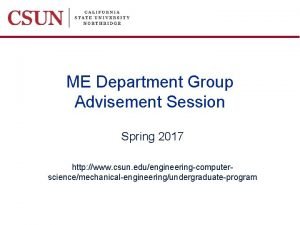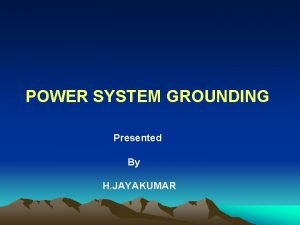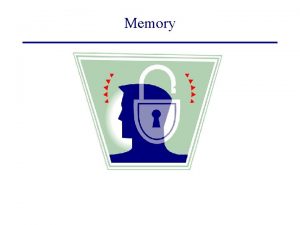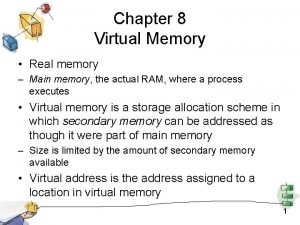VIRTUAL MEMORY WHY VIRTUAL MEMORY Weve previously required























- Slides: 23

VIRTUAL MEMORY WHY VIRTUAL MEMORY? We've previously required the entire logical space of the process to be in memory before the process could run. We will now look at alternatives to this. Most code/data isn't needed at any instant, or even within a finite time - we can bring it in only as needed. VIRTUES Gives a higher level of multiprogramming The program size isn't constrained (thus the term 'virtual memory'). Virtual memory allows very large logical address spaces. Swap sizes smaller.

VIRTUAL MEMORY Definitions Individual Pages Virtual Memory Map Physical Memory Disk

VIRTUAL MEMORY Definitions Demand paging : When a page is touched, bring it from secondary to main memory. • Virtual memory is implemented using demand paging • Rather than swapping the entire process into memory, we use a lazy swapper. A lazy swapper never swaps a page into memory unless that page will be needed. • In connection with demand paging, its technically suitable to use the term pager than swapper, as the swapper manipulates the entire processes, whereas a pager is concerned with the individual pages of a process.

VIRTUAL MEMORY Demand Paging When a page is referenced, either as code execution or data access, and that page isn’t in memory, then get the page from disk and re-execute the statement. Here’s migration between memory and disk. Program A Program B Physical Memory Disk

VIRTUAL MEMORY One instruction may require several pages. For example, a block move of data. Demand Paging Frame # 1 1 0 May page fault part way through an operation may have to undo what was done. Example: an instruction crosses a page boundary. Time to service page faults demands that they happen only infrequently. valid-invalid bit page table 0 Note here that the page table requires a "resident" bit showing that page is/isn't in memory. (Book uses "valid" bit to indicate residency. An "invalid" page is that way because a legal page isn't resident or because the address is illegal. It makes more sense to have two bits - one indicating that the page is legal (valid) and a second to show that the page is in memory. Frame # valid. Reside invalid nt bit 1 0

VIRTUAL MEMORY Demand Paging STEPS IN HANDLING A PAGE FAULT 1. The process has touched a page not currently in memory. 1. Check an internal table for the target process to determine if the reference was valid (do this in hardware. ) 1. If it was valid, but page isn't resident, then try to get it from secondary storage. 1. Find a free frame; a page of physical memory not currently in use. (May need to free up a page. ) 1. Schedule a disk operation to read the desired page into the newly allocated frame. 1. When memory is filled, modify the page table to show the page is now resident. 1. Restart the instruction that failed Do these steps using Figure 9. 4 which you can see on the next page.

VIRTUAL MEMORY Demand Paging

VIRTUAL MEMORY Demand Paging Performance of Demand Paging: • Effective access time=(1 -p) * ma + p * page-fault time

VIRTUAL MEMORY Page Replacement When it is needed? Choices- Terminate the User Process, Swap out an entire process, Page replacement Swap-out and Swap-in requires two page transfers- increases effective access time Solution- Modify Bit or Dirty Bit- bit is set by hardware whenever any word or byte in the page is written into, indicating that the page is modified.

VIRTUAL MEMORY Page Replacement PAGE REPLACEMENT ALGORITHMS: When memory is over-allocated, we can either swap out some process, or overwrite some pages. Which pages should we replace? ? <--- here the goal is to minimize the number of faults. Here is an example reference string we will use to evaluate fault mechanisms: Reference string: 7, 0, 1, 2, 0, 3, 0, 4, 2, 3, 0, 3, 2, 1, 2, 0, 1, 7, 0, 1 FIFO Conceptually easy to implement; either use a time-stamp on pages, or organize on a queue. (The queue is by far the easier of the two methods. ) For this reference string, there are 15 page-faults altogether.

…contnd Belady’s anomaly: in general, as the number of fames increases the page -fault rate will be decreased. But, for some page-replacement algorithms, the page-fault rate may increase as the number of allocated frames increases. This phenomenon is known as Belady’s anomaly. For eg: , the number of page-faults for four frames is 10, for the following reference string, whereas the number of page-fault rate for the same reference string with three frame is 9. Reference string: 1, 2, 3, 4, 1, 2, 5, 1, 2, 3, 4, 5

VIRTUAL MEMORY Page Replacement OPTIMAL REPLACEMENT • This is the replacement policy that results in the lowest page fault rate. • Algorithm: Replace that page which will not be next used for the longest period of time. • Impossible to achieve in practice Reference string: 7, 0, 1, 2, 0, 3, 0, 4, 2, 3, 0, 3, 2, 1, 2, 0, 1, 7, 0, 1 9 page faults

VIRTUAL MEMORY Page Replacement LEAST RECENTLY USED ( LRU ) • Replace that page which has not been used for the longest period of time. • Results of this method considered favorable. The difficulty comes in making it work. • Implementation possibilities: Time stamp on pages - records when the page is last touched. Page stack - pull out touched page and put on top Both methods need hardware assist since the update must be done on every instruction. So in practice this is rarely done. Reference string: 7, 0, 1, 2, 0, 3, 0, 4, 2, 3, 0, 3, 2, 1, 2, 0, 1, 7, 0, 1 12 page faults

VIRTUAL MEMORY LRU APPROXIMATION Uses a reference bit set by hardware when the page is touched. Then when a fault occurs, pick a page that hasn't been referenced. Additional reference bits can be used to give some time granularity. Then pick the page with the oldest timestamp. Second chance replacement: pick a page based on FIFO. If its reference bit is set, give it another chance. Envision this as a clock hand going around a circular queue. The faster pages are replaced, the faster the hand goes. Maintain a modified bit, and preferentially replace unmodified pages. Page Replacement

VIRTUAL MEMORY Page Replacement ADD HOC ( OR ADD-ON ) ALGORITHMS These methods are frequently used over and above the standard methods given above. Maintain pools of free frames; write out loser at leisure Occasional writes of dirties - make clean and then we can use them quickly when needed. Write out and free a page but remember a page id in case the page is needed again - even though a page is in the free pool, it can be recaptured by a process (a soft page fault. )

VIRTUAL MEMORY Page Allocation ALLOCATION OF FRAMES: What happens when several processes contend for memory? What algorithm determines which process gets memory - is page management a global or local decision? A good rule is to ensure that a process has at least a minimum number of pages. minimum ensures it can go about its business without constantly thrashing. This ALLOCATION ALGORITHMS Local replacement -- the process needing a new page can only steal from itself. (Doesn't take advantage of entire picture. ) Global replacement - sees the whole picture, but a memory hog steals from everyone else Equal vs. proportional allocation - pros and cons. Can divide memory equally, or can give more to a needier process. Should high priority processes get more memory?

VIRTUAL MEMORY Thrashing Suppose there are too few physical pages (less than the logical pages being actively used). This reduces CPU utilization, and may cause increase in multiprogramming needs defined by locality. A program will thrash if all pages of its locality aren’t present in the working set. Two programs thrash if they fight each other too violently for memory.

VIRTUAL MEMORY Thrashing If the process does not have this number of frames, it will quickly page fault. At this point, it must replace some page. However, since all its pages are in active use, it must replace a page that will be needed again right away. Consequently, it quickly faults again, and again. The process continues to fault, replacing pages for which it then faults and brings back in right away. This high paging activity is called thrashing

VIRTUAL MEMORY Locality of reference: Programs access memory near where they last accessed it. Thrashing

VIRTUAL MEMORY Working Set Model WORKING SET MODEL The pages used by a process within a window of time are called its working set. … 2 6 1 5 7 7 5 1 6 2 3 4 1 2 3 4 4 4 1 3 2 3 4 WS(t 1) = {1, 2, 5, 6, 7} WS(t 2) = {3, 4} Changes continuously - hard to maintain an accurate number. How can the system use this number to give optimum memory to the process?

VIRTUAL MEMORY Working Set Model PAGE FAULT FREQUENCY This is a good indicator of thrashing. If the process is faulting heavily, allocate it more frames. If faulting very little, take away some frames.

VIRTUAL MEMORY Other Issues PREPAGING • Bring lots of pages into memory at one time, either when the program is initializing, or when a fault occurs. • Uses the principle that a program often uses the page right after the one previously accessed. PAGE SIZE • If too big, there's considerable fragmentation and unused portions of the page. • If too small, table maintenance is high and so is I/O. • Has ramifications in code optimization.

VIRTUAL MEMORY Wrap up Virtual memory is how we stuff large programs into small physical memories. We perform this magic by using demand paging, to bring in pages only when they are needed. But to bring pages into memory, means kicking other pages out, so we need to worry about paging algorithms.
 Requi
Requi Weve a
Weve a Weve been lied to
Weve been lied to Weve got the beat
Weve got the beat Weve got this
Weve got this Pictures
Pictures Virtual memory
Virtual memory Virtual memory in memory hierarchy consists of
Virtual memory in memory hierarchy consists of Domain bacteria facts
Domain bacteria facts What thailand was previously known as
What thailand was previously known as Ncaa previously approved waivers
Ncaa previously approved waivers Csun previously disqualified questionnaire
Csun previously disqualified questionnaire Why grounding is required
Why grounding is required Different methods of size separation or
Different methods of size separation or Dont ask
Dont ask Spreading activation psychology
Spreading activation psychology Implicit memory vs explicit memory
Implicit memory vs explicit memory Long term memory vs short term memory
Long term memory vs short term memory Internal memory and external memory
Internal memory and external memory Primary memory and secondary memory
Primary memory and secondary memory Logical versus physical address space
Logical versus physical address space Which memory is the actual working memory?
Which memory is the actual working memory? Eidetic memory vs iconic memory
Eidetic memory vs iconic memory Shared vs distributed memory
Shared vs distributed memory









































